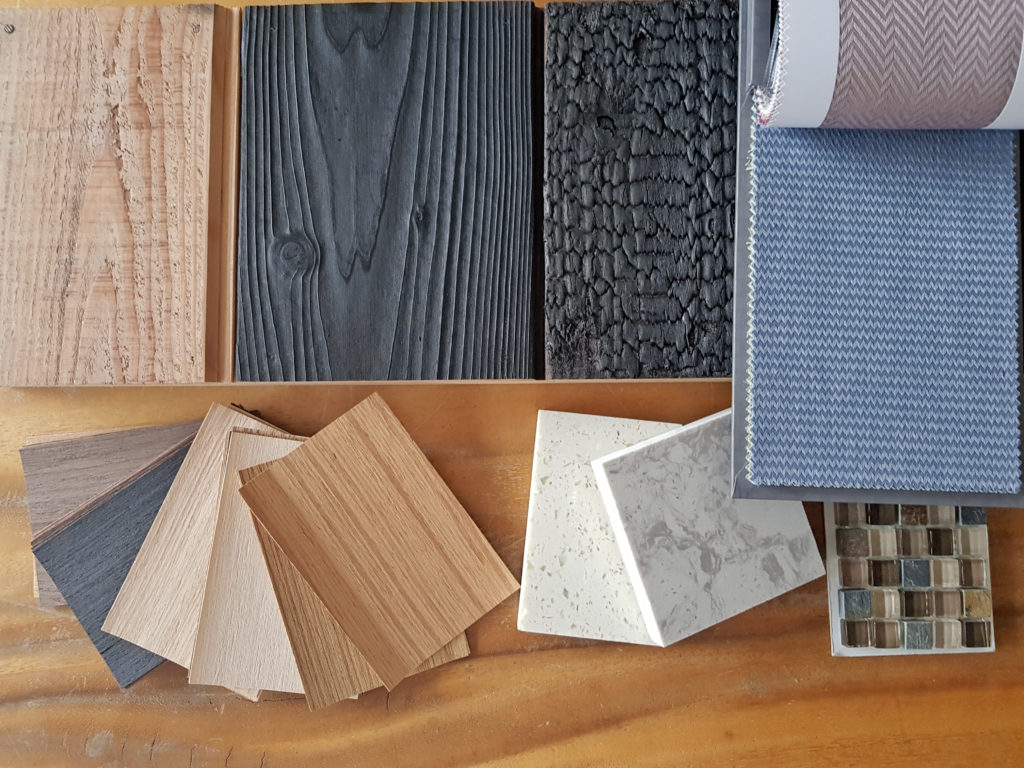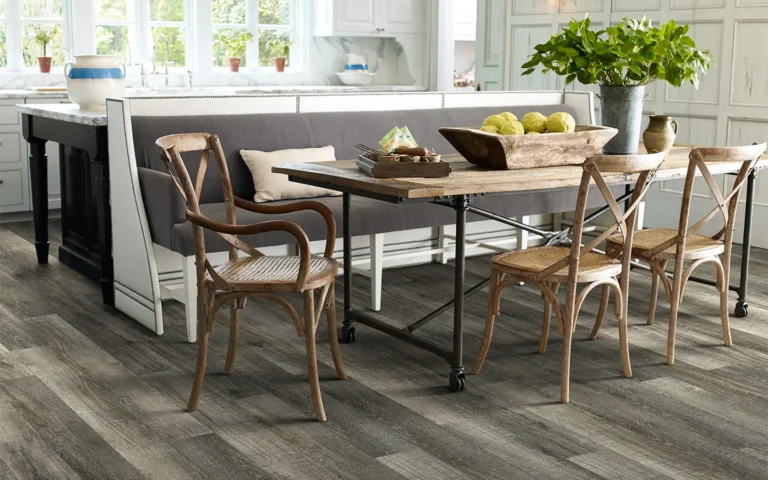This post may contain references or links to products from one or more partners of our parent company and/or subsidiaries of our parent company. For more information, visit this page.
November 19, 2020
When searching for environmentally friendly flooring, you’ll find tons of products made from all sorts of materials—wood, bamboo, cork, and more.
But here’s the catch: while certain types of flooring are advertised as environmentally friendly, you still need to look at each product’s specifics to determine how eco-friendly it actually is.
Why? There are very few products that meet environmentally friendly criteria in all aspects of their materials, production, shipping, and more.
As a homeowner, you need to weigh the benefits and drawbacks of these aspects as they relate to your eco-friendly flooring choices.
That’s why we’ve put together this guide to choosing environmentally friendly flooring. Below, we’ll teach you exactly what you need to look for in each flooring product—from peel-and-stick carpet tiles to the most durable wood flooring, even different types of floor tiles—so you can select the perfect product for you!
What Makes Flooring Environmentally Friendly?
For many homeowners, sustainability is an important factor during any remodeling project—especially where floors are concerned.
So: when it comes to choosing eco-friendly flooring, evaluate your choices based on these five 5 factors to help determine exactly how environmentally friendly your flooring is:
#1: Your Floor’s Durability
One of the most important elements to weigh when it comes to environmentally friendly flooring is durability.
Products that offer longer useful lives don’t need to be replaced as frequently—creating less waste and reduced pollution from its manufacturing processes. Durable flooring options also deliver value. Because they last longer, you don’t have to pay for new flooring many times throughout the years.
For example, from an environmental standpoint, one of the disadvantages of vinyl plank flooring is its synthetic (plastic) construction. But many people also see vinyl plank as an eco-friendly type of flooring because it never needs to be replaced. One floor can last 50 years or more!
#2: Your Floor’s Place of Origin
Flooring products come from around the globe. Materials may be sourced on one continent and manufactured on another. So when shopping for sustainable flooring, you need to consider where products come from.
Even if a finished flooring product is made in the USA, if its materials are sourced overseas, shipping those materials can result in significant carbon emissions. The most environmentally friendly flooring is produced locally!
#3: Your Floor’s Recyclability (and Recycled Content)
Eventually, all flooring reaches the end of its useful life and must be replaced. But what happens next to those old floors? Are they able to be recycled and turned into new products? Can they be repurposed for other uses? Or is a landfill their final destination?
While many of us aren’t thinking about the end of a floor’s life when selecting new surfaces, this is a key element to consider when it comes to environmentally friendly flooring, If your floors can’t be recycled, they could have a negative and lasting impact on the environment long after they’re out of your house.
Solution: buy floors that can be recycled. Or, buy floors that are made from recycled content! Choosing flooring products composed of recycled materials helps reduce waste at the end of the item’s lifecycle. For example, some low-VOC carpet can be made from recycled bottles or rubber flooring from old tires.
#4: Your Floor’s Raw Materials—Renewable or Otherwise
Many flooring types are composed largely or partially of renewable natural resources. Even the best engineered wood flooring is partially made of easily renewable plywood.
Renewable resources are those that can be replenished. The bamboo forests used to manufacture the best bamboo flooring, the wood used by the best hardwood floor brands, even the clay used to create scratch-resistant flooring tiles—are of these are renewable materials that can be replanted or recreated.
Hemp flooring, for instance, is incredibly easy to regrow. In fact, a hemp stalk can grow from seed to harvest-ready stem in as little as 120 days!
However: just because a material is renewable doesn’t mean it’s actually being renewed or harvested responsibly. For example, if you look into some teak flooring pros and cons, you’ll find that even though teak can be harvested renewably, illegal harvesting is still a massive problem.
Solution: when selecting environmentally friendly flooring, make sure you look for third-party certifications that ensure renewable production.
Best Brands of 2024
#5: Your Floor’s VOC Levels
VOCs stands for volatile organic compounds, chemicals produced by all sorts of industrial manufacturing. That new-car smell? VOCs. Tragic, we know.
Unfortunately, if you don’t buy low-VOC flooring, certain products can off-gas these harmful chemicals in your home. And while we encounter VOCs in all sorts of places, a high concentration of VOCs in enclosed rooms can pose a health risk to vulnerable groups.
Limit health risks to your family and damage to the environment by choosing or products that contain no VOCs. Look for low-VOC vinyl flooring brands like Proximity Mills or non-toxic laminate flooring—or carpets containing low levels of VOCs.
One more important note about VOCs in flooring:
Not all products are created equal. While some types of wood flooring may be harvested sustainably, they may be treated with resins or stains that emit VOCs. And natural materials packed with VOCs lose their status as “environmentally friendly flooring”.
All in all: due to a lack of universal standards as well as the greenwashing phenomenon, you can’t always trust that a product labeled “green” or “eco-friendly” really is.
For these reasons, you have to evaluate these 5 factors of environmentally friendly flooring to determine which products you feel comfortable purchasing and using in your home.
Different Types of Environmentally Friendly Flooring

Now that we know how to evaluate the environmental friendliness of different flooring products, let’s take a look at some specific types of flooring and see how they measure up when it comes to health and sustainability.
Hardwood Flooring
Hardwood has always been a popular choice for flooring in homes. And it’s easy to see why; it’s gorgeous, it feels great, and it almost always increases resale value.
Sure, the cost to replace carpet with hardwood is prohibitive for some budgets—but there are a variety of hardwood floor alternatives available at a more manageable price tag.
Just remember: different types of fake wood flooring like laminate and vinyl plank may not qualify as environmentally friendly flooring the same way real wood flooring does.
There are Several Certifications That Ensure Wood is Sustainably Harvested
Wood is a renewable resource, and there are organizations that work to ensure wood is responsibly harvested and does not contribute to deforestation. These include the Forest Stewardship Council and the National Wood Flooring Association’s Responsible Procurement Program.
When you buy a product that’s certified by one of these organizations, you know you’re getting sustainable wood flooring that won’t harm Mother Nature.
Domestic Hardwoods are More Environmentally Friendly than Exotic Woods
Much of the wood used in the American flooring industry is harvested in the eastern US—ash flooring, for example. This limits the pollution caused by transporting materials from source to manufacturer.
It’s also why domestic hardwoods are often less expensive than exotic hardwoods. If you compare the disadvantages of hickory vs. oak flooring, you’ll find that both are often sourced from US forests, even though they grow around the globe. That’s because it’s cheaper (and more environmentally friendly) to grow those trees right here in the US!
Exotic products like ebony flooring, on the other hand, have to be imported. And because they have to be shipped in from overseas, they don’t qualify as environmentally friendly flooring the way domestic woods do.
Additionally, overseas products can be harder to monitor, so it may be more difficult to know if your wood is being harvested in an environmentally friendly way.
Wood Floors Can Last a Lifetime (Making Them More Sustainable)
Wood flooring products are incredibly long-lasting. Solid wood floors can last a lifetime or more. In fact, with proper care, hardwood floors can last hundreds of years—which is why original wood floors can still be found in many older homes across the country.
But Solid Hardwood is More Sustainable Than Engineered Hardwood
Just remember: one of the biggest engineered wood disadvantages is that it can only be refinished a few times (if at all). So if you want your wood floors to last forever, solid wood is probably the better option.
Of course, the cost to install engineered hardwood floors can be more budget-friendly (as engineered wood can often be installed as click-together flooring). So it’s really about balancing your need for affordable flooring with your need for environmentally friendly flooring.
Just Remember: Hardwood and Hardwood Alternatives are Not the Same!
It’s important to remember that while some hardwood floor alternatives (like Mohawk’s RevWood) might look just like real wood, they are not made of real wood. That means they can’t be refinished like real wood can be! And it also means that they can’t always be recycled or reused the way hardwood can.
How to Find Environmentally Friendly Wood Flooring
- Look for products that are certified by the NWFA’s Responsible Procurement Program and/or the Forest Stewardship Council (both of which we mentioned above).
- When buying imported hardwood flooring, don’t trust packaging or product descriptions. A 2019 World Wildlife Fund study found that up to 62% of US wood products are mislabeled. Mislabeling can be an indication that resources were illegally harvested, which contributes to rapid deforestation.
- Look for wood flooring with a GREENGUARD Gold Certification from UL (Underwriters Laboratories), which indicates the product has been tested and verified to emit limited levels of VOCs.
- Consider installing reclaimed wood flooring. Reclaimed wood flooring is salvaged from old homes, buildings, and barns, and restored before new installation. Reclaimed wood prevents overharvesting, as well as the pollution involved in producing and shipping new floors.
Bamboo Flooring
Over the last several years, bamboo flooring has increased in popularity for residential use. It offers many of the same desirable properties as hardwood, with tons of added perks. Plus, it can be used to create timeless wood floor patterns like herringbone and chevron parquet.
Is Bamboo Environmentally Friendly Flooring?
It absolutely can be! Bamboo is a highly renewable resource with an incredibly fast growth rate. Bamboo plants can reach maturity in under five years. Additionally, bamboo plants are not killed or damaged during harvest (which only takes the uppermost stalks).
Bamboo Grows Super Fast
Bamboo stalks are cut by hand at the middle of the plant every 3 to 5 years or so. This protects the integrity of the bamboo plant and prevents the need for replanting. Each plant grows new chutes every year, which can grow at a rate of up to one foot per day!
But It Usually Has to Be Imported
Bamboo grows in tropical and subtropical areas, and the majority of bamboo used in flooring is sourced from China and other Asian countries. Some bamboo flooring products are manufactured in China and imported to the US; others are made in the US with imported materials.
Either way, the resource or product must travel considerable distances, generating more pollution than other types of eco-friendly flooring that are sourced closer to home.
Additionally, pesticide monitoring of bamboo crops does not occur in China, so growing practices may not be as environmentally friendly as they should be.
And There Are Some Issues With Overharvesting
While bamboo’s rapid regeneration and sustainable harvest methods seem like a win-win, there are some negative impacts that can make it not such environmentally friendly flooring.
As bamboo has grown in popularity, growers have expanded fields to plant more bamboo—which restricts land dedicated for other purposes, disrupting the balance and biodiversity of local environments.
As more and more bamboo forests are clear-cut, local ecosystems and animal habitats are destroyed. And we would never want to deprive adorable baby pandas of their habitats!
Like Wood, Bamboo Flooring Can Last a Very Long Time
Bamboo floors can last a very, very long time with proper maintenance. But like hardwood, it depends on the specific product. If you look into some engineered bamboo flooring pros and cons, you’ll find that, like wood, engineered bamboo can only be refinished a couple of times at most.
Some Types of Bamboo Flooring May Have More VOCs Than Others
Horizontal and vertical bamboo floors are durable, but strand-woven bamboo is super durable. However, strand-woven bamboo is compressed with resins, which can contain high levels of VOCs. Solution: make sure you ask your local flooring experts which bamboo products they’d recommend as the most environmentally friendly flooring.
Bamboo Can Be Installed in a Number of Environmentally-Friendly Ways
Like wood, bamboo can be installed as a nail-down, staple-down, glue-down, or floating floor. One of the disadvantages of floating floors is that the surface can sustain wear faster, meaning it’ll have to be replaced sooner. But floating floors don’t need adhesives to be installed, which means fewer VOCs in the home.
Nail-down and staple-down floors are also great in this regard; it just depends on what kind of subfloor you have. And if you’re wondering what subflooring is, it’s just the rough base surface you attach your floor to.
How to Find Environmentally Friendly Bamboo Flooring
- As with wood, look for bamboo flooring that has an FSC certification to ensure you’re installing truly environmentally friendly flooring.
- Beware of VOCs. Urea-formaldehyde adhesive is applied to most bamboo flooring products during the lamination process of manufacture. There are bamboo floor products available that are formaldehyde-free—you just have to find them!
- Buy your bamboo flooring from a flooring store near you—not from a big box store. Local flooring retailers know exactly what’s in their products and where they come from. Box store clerks who don’t specialize in flooring? Not so much.
Cork Flooring
Cork flooring has existed for ages, but it has recently experienced a surge in popularity.
What Makes Cork Such Environmentally Friendly Flooring?
Cork floors are incredibly sustainable, because harvesting cork does not involve cutting down a tree!
Rather, cork is made from the bark of the cork oak tree. The tree itself isn’t damaged, and can be harvested again and again and again, every ten or so years, for approximately two hundred years.
Even better: cork flooring is actually made from the waste left over after wine corks are produced. So really, it has all sorts of environmentally friendly flooring cred.
Cork is Antimicrobial, Mold-Resistant, and Insect-Resistant
Cork contains naturally high concentrations of suberin, giving the material antimicrobial properties. It is highly resistant to moisture, mold, and mildew as well as termites, which helps it withstand cracks, cuts, and other damage that can reduce the material’s useful life.
This means that cork flooring can last longer than similar floors, making it a more sustainable option.
And Cork Can Improve Energy Efficiency
Cork floors are a natural thermal insulator, which helps prevent heat loss in homes. Translation: less heat is needed to warm a cork-floored household, improving its household’s energy efficiency.
But Cork is Not Generally Grown Domestically
Unfortunately, much of the cork used in the flooring industry is grown in Southern Europe—meaning it has to be shipped to manufacturers or consumers. And shipping means carbon emissions.
And Certain Cork Products Can Off-Gas VOCs
Because cork flooring is made by grinding up cork bark and binding it with resins, it can contain significant levels of VOCs. Again: not all cork flooring contains VOCs—but it is something you have to watch out for.
With Proper Maintenance and Resealing, Cork Can Sustainably Last for Decades
Maintenance is required to keep cork floors looking their best and lasting as long as possible, which can be 40 or more years.
After installation, the floors must be sealed to eliminate the possibility of swelling—polyurethane is recommended as a low-VOC sealant for cork to prevent off-gassing.
Resealing is typically required every five to eight years, which—if we’re being honest—can be one of the disadvantages of cork flooring for many homeowners.
Another Environmentally Friendly Flooring Perk: Cork is Biodegradable!
Unlike many other types of environmentally friendly flooring, cork is fully biodegradable. Translation: if you buy a cork product that doesn’t use chemical resins, it can be fully recycled once flooring is removed from the home. No sitting in a landfill for 10,000 years—just good old-fashioned biodegradation!
How to Find Environmentally Friendly Cork Flooring
- Look for products that are FSC-certified or PEFC-certified to ensure materials were harvested sustainably.
- The Programme for the Endorsement of Forest Certification (PEFC) is a global organization dedicated to encouraging sustainable forest management, including cork producers in Southern Europe.
- Again, buy your cork flooring from an independent flooring retailer rather than from a box store. Most of Lowe’s cork flooring, for instance, isn’t really cork flooring at all!
- Cork flooring materials need to be sealed and can be stained to change their color. When purchasing colored cork or staining it yourself, choose low-VOC stains to minimize off-gassing.
Tile Flooring
Tile is another versatile option. In the past, tile floors were mostly used for kitchen, bathroom, and mudroom flooring. But with modern tile designs and installation options (like snap-together tile flooring), it’s becoming more and more popular throughout the home.
Are Tiles Environmentally Friendly Flooring?
Flooring tiles can be made from many different materials—ceramic, porcelain, glass, and stone, to name a few. Sustainability and environmental friendliness vary between these different types of tiles.
Porcelain and Ceramic Tiles are Made From Eco-Friendly Materials
Porcelain and ceramic tiles are made of clay, which is a naturally occurring material. It’s sustainable, it can be sourced locally, and it’s easy to collect—minimizing carbon emissions from mining equipment.
They Can be Recycled
Additionally, these tiles can be recycled—and also made from recycled materials! Plus, porcelain and ceramic are simply made from clay that’s baked at a high temperature, meaning VOCs in the product are minimal.
Plus, They’re Durable and Long-Lasting
Ceramic and porcelain floor tiles are difficult to crack and are not prone to water damage, which gives tile a big advantage when comparing tile vs. laminate flooring. Ceramic tiles have an expected lifespan of 75 to 100 years.
Glass Tiles Take Even Less Energy to Produce (and Are Also Recyclable)
Glass tiles require about half the amount of energy to produce as ceramic tiles. You can also find tiles made from recycled glass. Glass tile is water-resistant and does not crack unless heavy, direct force is applied, so they can last for decades.
However, glass tiles are prone to scratches, so early replacement may be needed for aesthetic reasons. But again—they’re recyclable and can be repurposed for other applications.
Stone Tile is Super Durable, But May Not Be as Renewable
Stone tiles made from quartz, marble, granite, and other natural materials may not be as renewable (since stone can’t simply be regrown).
But, they have many characteristics that distinguish this option as a relatively environmentally friendly flooring choice. Today’s stone quarries often use efficient technologies and methods to minimize emissions and negative impacts on their surrounding environments.
Many stone tiles can be sourced in the US, such as granite and limestone, while many marble tiles come from Italy, and travertine is largely sourced from Turkey. Emissions from shipping tile internationally make some choices less environmentally friendly than others. Stone tile is extremely durable and can last hundreds of years, requiring little maintenance.
How to Find Environmentally Friendly Tile Flooring
- Look for a material that’s recyclable (ceramic, porcelain, and glass are good options).
- Whenever possible, purchase materials sourced from the US rather than from overseas.
- Ensure that any and all adhesives and grouts used to install your tiles are low in VOCs.
- Consider tiles made of recycled content or salvaged tiles that have been removed from other applications.
Laminate and Vinyl Plank Flooring
We haven’t talked about these popular wood floor alternatives yet, because they’re not generally thought to be super environmentally friendly flooring choices (particularly vinyl plank).
But these days, it is possible to buy eco-friendly laminate and vinyl flooring. You just need to know what to look for.
What’s the Difference Between Vinyl Plank (aka LVT) and Laminate?
If you compare the makeup of vinyl plank vs. laminate, you’ll find a lot of similarities. Both of these floors are multilayer composites that can mimic wood and tile flooring extremely accurately. In fact, it’s really hard to tell the difference these days!
But while laminate flooring is made of wood by-products, plastic, and printed images, vinyl plank flooring is usually made entirely of plastic.
The Plastic in These Floors is Not Very Eco-Friendly
More specifically, vinyl plank/LVT is made of polyvinyl chloride—PVC. This plastic is used in tons of products, but it’s not very eco-friendly. It can emit VOCs after installation, it can’t be recycled, it’s not biodegradable, and like all plastic, it is not sustainable.
Laminate flooring, while not made entirely of plastic, does contain plastic (especially in its wear layer). Additionally, the adhesives used to join its multiple layers may contain VOCs.
However, These Floors Can Last a Very Long Time (Meaning Less Waste)
On the other hand, these floors are known for being extremely long-lasting. Many vinyl plank floors come with decades-long warranties. And if you compare carpet vs. laminate or other soft surfaces, you’ll find that laminate offers way more longevity.
Of course, the longer a floor lasts, the less it has to be replaced. And that means less waste all around.
There are Eco-Friendly Laminate and Vinyl Plank Options Out There
In recent years, some manufacturers have started producing no- or low-VOC vinyl as an environmentally friendly flooring alternative to traditional vinyl.
It is recyclable and made from PVC-free recycled content. The same is true for laminate flooring. Check out some Pergo Extreme reviews to read what buyers are saying about these ultra-popular vinyl options and you’ll see what we mean.
You Can Easily Install Laminate and Vinyl Plank Without Adhesives
Laminate and vinyl plank are among the easiest types of flooring to install, as they can both be put in as click-together flooring. We mentioned this above, but click-together floors can be put in without adhesives (and therefore, without the VOCs adhesives can release).
How to Find Environmentally Friendly Laminate or Vinyl Plank Flooring
- As always, try to find products that are manufactured domestically—Mohawk’s waterproof laminate RevWood, for instance.
- Look for products that boast a GreenGuard, GreenGuard Gold, and/or FloorScore certification.
- Ask your local flooring expert about the newest environmentally friendly flooring options. There are new laminate and vinyl choices coming out every day!
Carpet Flooring
Until recently, carpet was not typically on a homeowner’s list for environmentally friendly flooring options. But today, there are a number of renewable and recycled carpet products to choose from.
Carpet is Evolving Towards Sustainability
Traditional carpet is often made from synthetic materials, which can use harmful chemicals in manufacture. Like vinyl plank, these materials cause VOC emissions and are not recyclable.
Recently, however, materials and manufacturing processes have evolved to produce carpets that are much better for the environment.
Natural Fibers and Recycled PET Are Two of the Most Environmentally Friendly Options
Environmentally friendly carpets can be made from natural fibers that are not exposed to heavy chemical treatment. Wool carpets have been around for centuries, and are now gaining traction as the industry moves to produce more sustainable products.
Jute and cotton are two other natural and renewable fibers used to create modern carpets. Recycled content is also available, such as PET carpets composed of recycled plastic bottles.
Carpet Pads and Adhesives Aren’t Traditionally Eco-Friendly (But They Can Be)
Carpet padding has traditionally been made using petroleum, a nonrenewable resource that contributes to excessive energy consumption. New products are available that can be installed without padding to eliminate the use of this product altogether.
Also, new padding options have been created which are made from recycled materials. Manufacturers are also moving to safer dyes and nontoxic adhesives to limit VOC emissions.
And Some Carpets Can Now Be Recycled
Until recently, carpet was typically thrown out at the end of its life, adding significant waste to landfills. Today, many manufacturers offer take-back programs for their products.
How to Find Environmentally Friendly Carpet Flooring
- Look for materials made from natural or recycled materials.
- Try to purchase carpets from manufacturers that offer carpet take-back programs.
- Look for GreenGuard and/or FloorScore certifications to ensure a lower-VOC option.
Which Environmentally Friendly Flooring is Right For You?
Selecting environmentally friendly flooring is a personal choice. You need to determine which factors make the biggest environmental impact for you.
But now that you know how to evaluate the key factors of environmentally friendly flooring, it’s time to begin your search! Use our locator tool to find highly-rated flooring stores near you. After all, local retailers are the real environmentally friendly flooring experts!
And for more information on different types of flooring, check out:
About The Author

Amanda Balz
November 19, 2020
Amanda Balz is a full-time content creator and consultant based out of Indianapolis, IN. After work, you can find her sewing, raising a wild child, watching dog videos online, or out exploring.





